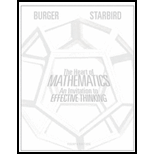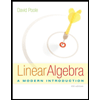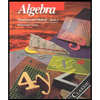
The last one. Here is a game to be played with natural numbers. You start with any number. If the number is even, you divide it by 2. If the number is odd, you triple it (multiply it by 3), and then add 1. Now you repeat the process with this new number. Keep going. You win (and stop) if you get to 1. For example, if we start with 17, we would have:
Play four rounds of this game starting with the numbers 19, 11, 22, and 30. Do you think you will always win no matter what number you start with? No one knows the answer!
Want to see the full answer?
Check out a sample textbook solution
Chapter 2 Solutions
The Heart of Mathematics: An Invitation to Effective Thinking
Additional Math Textbook Solutions
Finite Mathematics for Business, Economics, Life Sciences and Social Sciences
Introductory Combinatorics
A Problem Solving Approach To Mathematics For Elementary School Teachers (13th Edition)
A Problem Solving Approach to Mathematics for Elementary School Teachers (12th Edition)
Calculus Volume 2
Differential Equations: An Introduction to Modern Methods and Applications
- A commuter must travel from Ajax to Barrie and back every day. Four roads join the two cities. The commuter likes to vary the trip as much as posible, so she alwaysleaves and returns by different roads. In how many different ways can she make the round-trip?arrow_forwardAlice and Bill have four grandchildren, and they have three framed pictures of each grandchild. They wish to choose one picture of each grandchild to display on the piano in their living room, arranged from oldest to youngest. In how many ways can they do this?arrow_forward
 Algebra and Trigonometry (MindTap Course List)AlgebraISBN:9781305071742Author:James Stewart, Lothar Redlin, Saleem WatsonPublisher:Cengage Learning
Algebra and Trigonometry (MindTap Course List)AlgebraISBN:9781305071742Author:James Stewart, Lothar Redlin, Saleem WatsonPublisher:Cengage Learning
 College AlgebraAlgebraISBN:9781305115545Author:James Stewart, Lothar Redlin, Saleem WatsonPublisher:Cengage Learning
College AlgebraAlgebraISBN:9781305115545Author:James Stewart, Lothar Redlin, Saleem WatsonPublisher:Cengage Learning Linear Algebra: A Modern IntroductionAlgebraISBN:9781285463247Author:David PoolePublisher:Cengage Learning
Linear Algebra: A Modern IntroductionAlgebraISBN:9781285463247Author:David PoolePublisher:Cengage Learning Holt Mcdougal Larson Pre-algebra: Student Edition...AlgebraISBN:9780547587776Author:HOLT MCDOUGALPublisher:HOLT MCDOUGAL
Holt Mcdougal Larson Pre-algebra: Student Edition...AlgebraISBN:9780547587776Author:HOLT MCDOUGALPublisher:HOLT MCDOUGAL Algebra: Structure And Method, Book 1AlgebraISBN:9780395977224Author:Richard G. Brown, Mary P. Dolciani, Robert H. Sorgenfrey, William L. ColePublisher:McDougal Littell
Algebra: Structure And Method, Book 1AlgebraISBN:9780395977224Author:Richard G. Brown, Mary P. Dolciani, Robert H. Sorgenfrey, William L. ColePublisher:McDougal Littell





